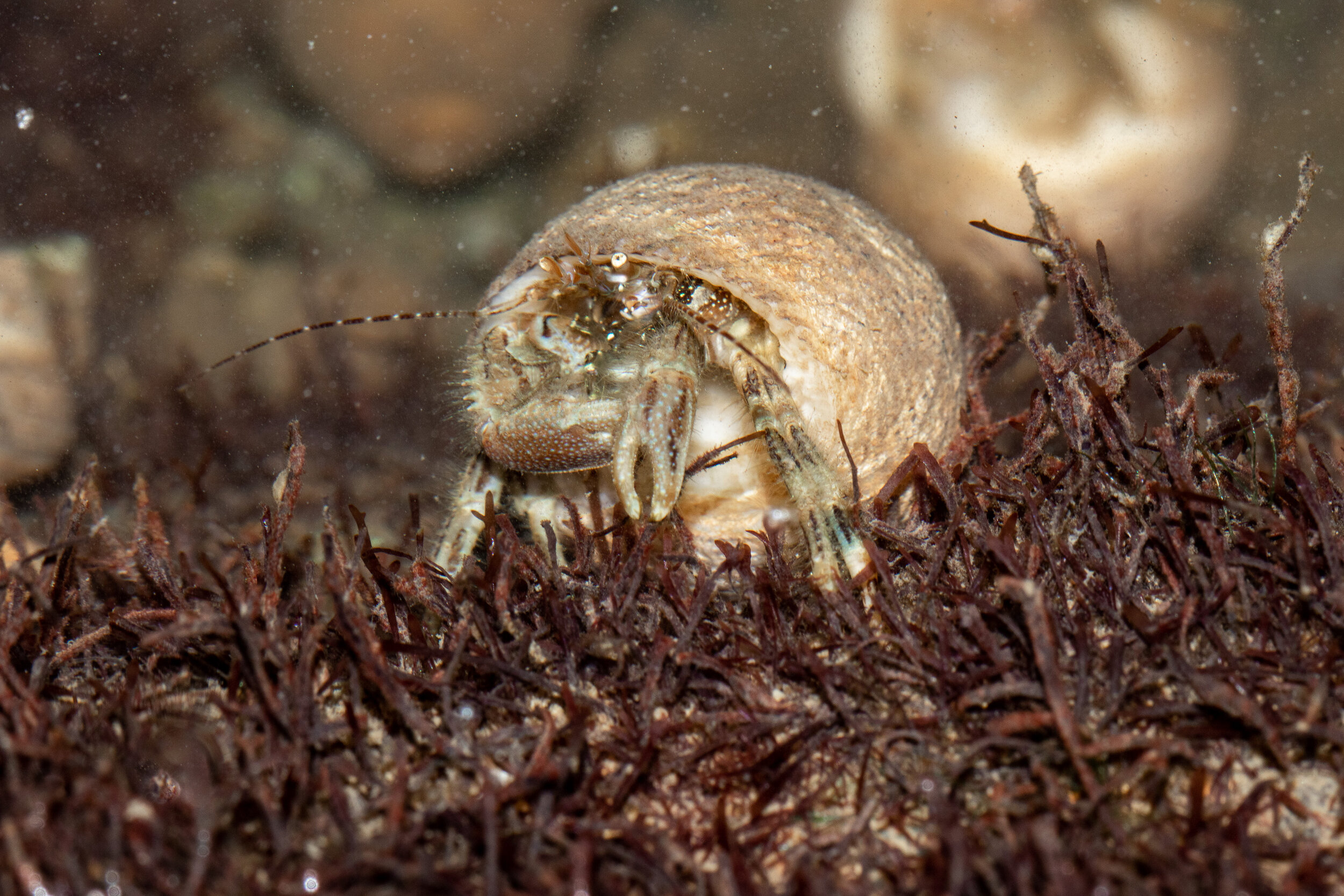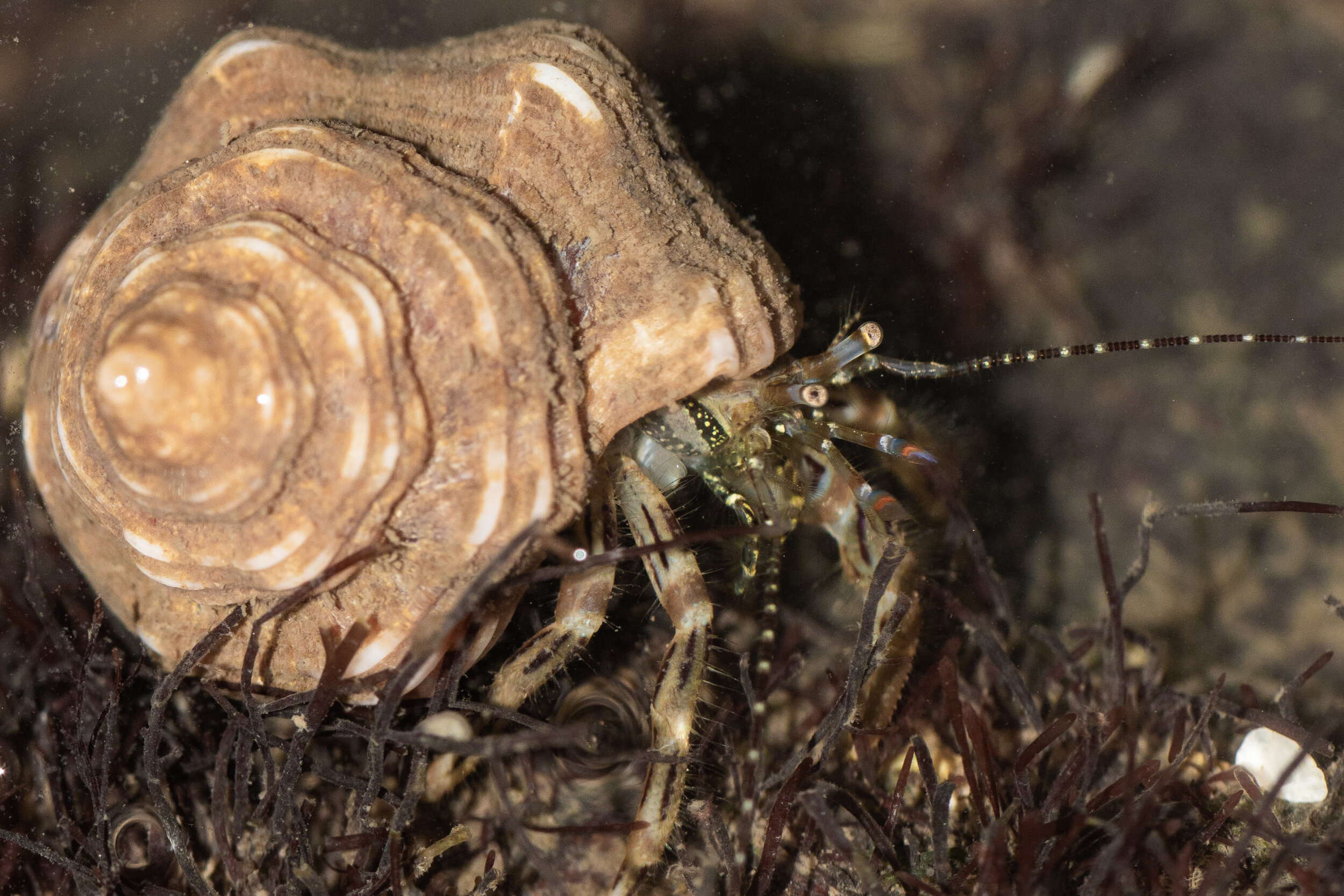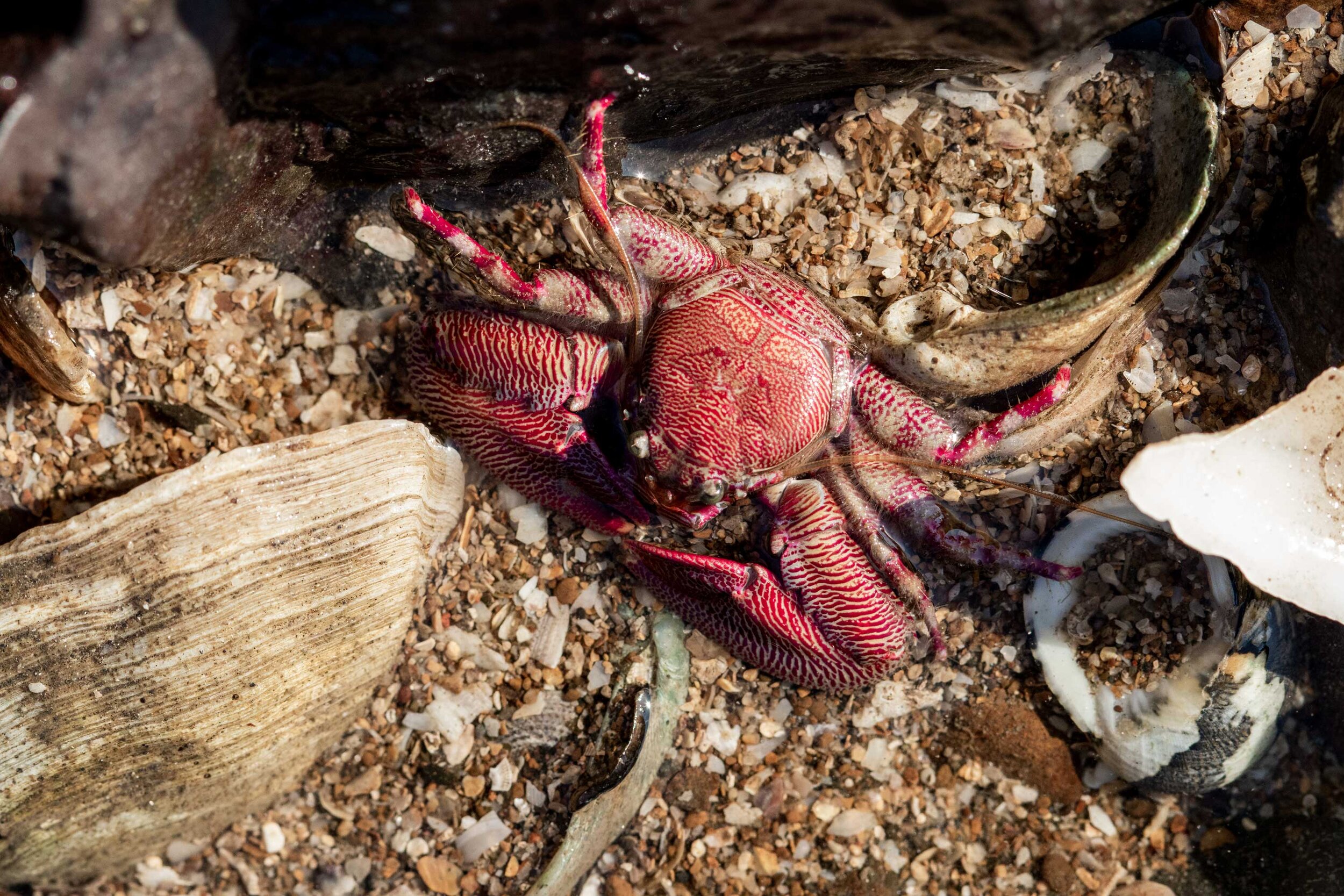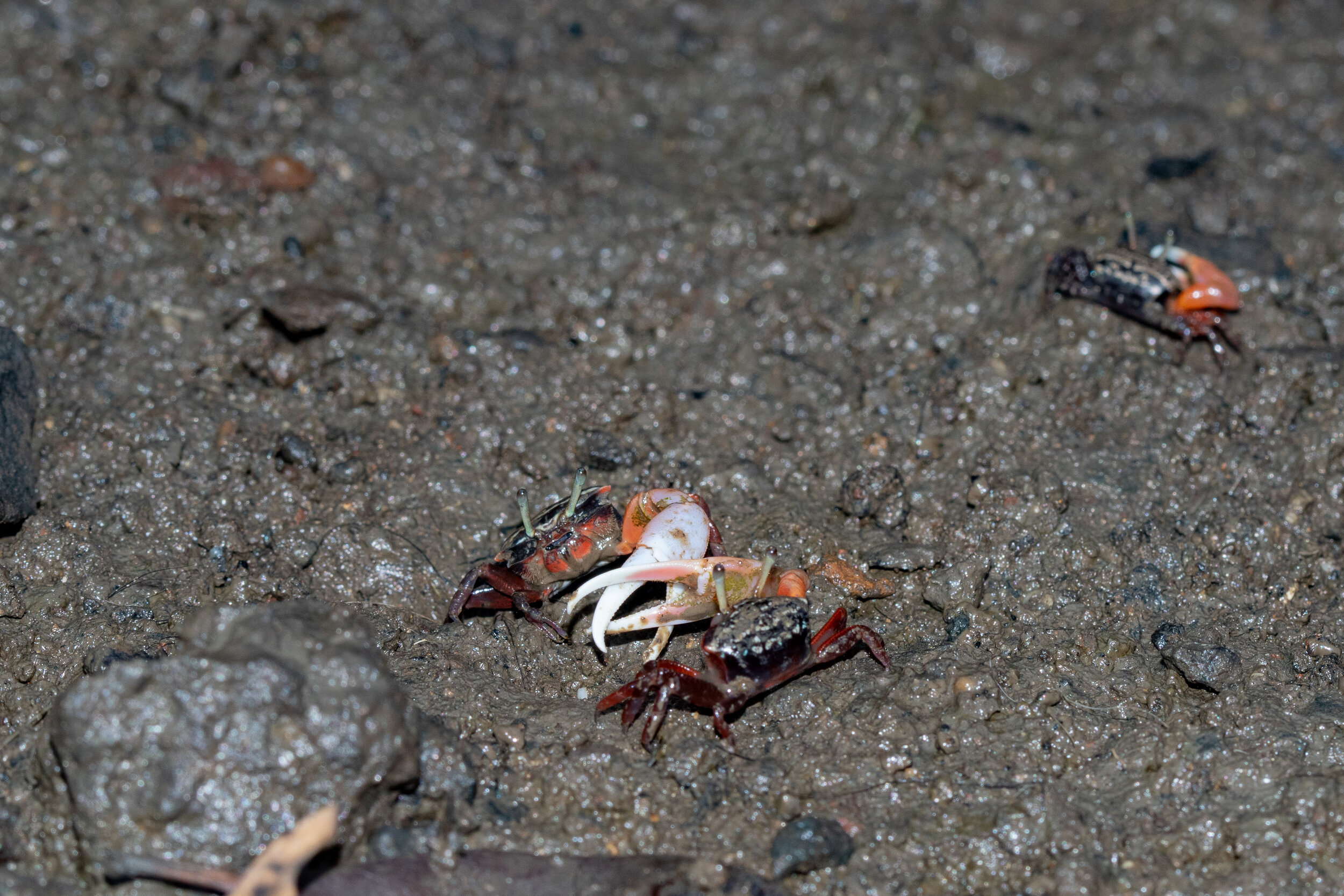
Crab Walk

Horned Ghost Crab
Scientific Name: Ocypode ceratophthalmus
Order: Decapoda
Family: Ocypodidae
Size: 1 to 2 inches across the carapace
Habitat preference: Sandy shore
Substrate: Loose sand
Okay, stay very still. Any movement will send this creature scurrying away into its burrow.
You’ll meet this crab often while walking along the upper intertidal - the fast-footed Horned ghost crab. It zips across the sand at the speed of 100 body lengths per second, speed that can easily beat the cheetah's 10 body lengths per second. It gets its common name from the pale colouration of its body and its ability to blend in with the sandy habitat. Like some of its intertidal neighbours, it is a generalist scavenger, eating everything from worms to small dead fish, shrimps and even other small crabs. By night, it's a predator of small animals, eating clams and snails by the water's edge.
While it is a marine creature, the ghost crab makes its home in an area that seldom gets wet.
The ghost crab gets its common name from its ability to blend in with the sandy habitat.
Unlike the other crabs on this walk, the ghost crab uses wetness differently. While it is a marine creature, it makes its home in an area of the intertidal that seldom gets wet. We’ll move slightly closer to the water’s edge, come along.

Banded Hermit Crab
Banded hermit crab feeding on red algae
Scientific Name: Pseudopaguristes sp.
Family: Diogenidae
Order: Decapoda
Size: 1 to 2 inches
Habitat preference: Sandy & Rocky shores
Substrate: Mixed
What do you see? Shells moving along with tiny legs scuttling across the habitat? Shells belong to sea snails of course, so if you guessed that, it's understandable. But that's a hermit crab. See how it scuttles as opposed to a sea snail's smooth glide? This one here is just one of the multiple species found in Mumbai. If you try to pick one up, it'll just retreat far inside its shell, and hide out the disturbance.
You’ll see it almost every time you visit a shore - the hermit crab. Unlike the ghost crab, there’s no way to miss these. They’ll be the ones struggling along the intertidal with shells that have been abandoned by sea snails. Why? Well, hermit crabs are not true crabs, in that they’re not born with a hard carapace protecting their bodies. So, to escape desiccation and predation, they wear what has been discarded by others as protective homes. As they grow in size, they need to look for newer, roomier shells; the hermit crab lives up to its name.
In the last four years, we have seen hermit crabs in large numbers and on every single shore we visited, and over a large portion of each of these shores. Different hermit species have different diets: many are omnivores, but some are strict scavengers or carnivores, while other species catch floating particles from the water. And some species use a mix of these.
We have also observed hermit crabs actively engaging, quite brutally with each other; on one occasion, a team member documented one literally ripping a leg off from another individual. Whether this was to acquire a new shell or a bullying tactic is still undetermined. As you can see there are a fair few here as well, sit long enough, and we’ll see some interactions.
Hermit crabs interact with each other on the shore. To what purpose, beyond shell acquisition, is a question that remains unanswered.
A hermit navigating a colony of Green button polps (Palythoa mutuki).
Hermit crabs wear shells discarded by other animals as protective homes.
Hermit crabs feeding on hydriods at Bandstand, Bandra.

Porcelain Crab
Scientific Name: Petrolisthes boscii
Family: Porcellanidae
Order: Decapoda
Size: 2-5cm
Habitat preference: Rocky shores
Substrate: Under rocks
We’re switching shores, folks. This particular crab likes the rocky shoreline. Watch your step, rocky shores are slippery, and a fall here hurts - either you’ll get cut on a barnacle or oyster, or you’ll break some part of you on hard rock.
Look around. Observe how this is different from a sandy beach. Boulders, cobbles, pebbles make up this intertidal, and creatures live among crevices and under shelter when they can. The water recedes leaving tidepools where animals gather in and around at low tide.
Here, let’s pick up a rock.
There it is. Rocky shores usually host this stunning pink-maroon striped crab.
Step back, don’t scare it, it’ll vanish in a second.
Colouration can vary between species; we have seen this pink individual most often. The juveniles we have observed are pink and white in colour here in Mumbai (and we’ve often seen them on Sea sponge). True crabs have four pairs of walking legs and short antennae, the porcelain crab has only three pairs and long-reaching antennae. Porcelain crabs are anatomically and genetically closer to lobsters than to the ‘real’ crabs. They filter feed, meaning they trap tiny drifting food using their hairy mouth parts.
But what gets this animal its name? When stressed, or while escaping a predator, the delicate porcelain crab will voluntarily shed its limbs in a bid to get away. It literally breaks, like porcelain. Like in one of the photos below, we’ve come across broken limbs of this crab often on the intertidal. Our records have also shown them being predated on by larger crabs.
Porcelain crabs are anatomically and genetically closer to lobsters than to the ‘real’ crabs.
The porcelain crab has only three pairs and long-reaching antennae.
These crabs prefer the underside of rocks and in between crevices, they’ll run as soon as it senses danger.
Since it uses autonomy to escape, you’ll often find their discarded limbs on the shore.
Let’s not stress it here, though. Let’s keep going.

Maroon Stone Crab
A maroon rock crab in a crevice
Scientific Name: Menippe rumphii
Family: Menippidae
Order: Decapoda
Size: 10-15cm
Habitat preference: Rocky shores
Substrate: Under rocks and in crevices
Walk on carefully to this pool here, and peek slowly under this rock. There's an animal here trying valiantly to be invisible by pretending to be still. See how it takes its limbs under it. It's doing a pretty good imitation of being a rock. And that is how it gets its name.
Another commonly seen citizen on the rocky shore is the Maroon stone crab. This crab - of generous bulk - is actually a part of our seafood. Stone crabs lives in crevices on rocky shores. They are collected by fishers for consumption and sale and are fairly easy to spot and pick because of their size. You can keep your distance, although despite its size, we have experienced that it’s not a temperamental creature, preferring the safety of a crevice rather than engaging. In fact, if you do lift a rock and come across this one, unlike other crabs that will literally scatter (or fight in defence like a clapping crab), Menippe will tuck its limbs under its body and remain motionless.
On our forays, we have seen this crab feeding on small crabs as well as worms.
Unlike other animals in their habitat, these crabs prefer waiting out the tide in crevices.
Unless you look intently, you might mistake them for a reddish stone.
A juvenile Maroon stone crab.

Ring-legged Fiddler Crab
Ring-legged fiddler crabs in a territorial fight
Scientific Name: Austruca annulipes
Family: Ocypodidae
Order: Decapoda
Size: 2-3cm
Habitat preference: Muddy shores
Substrate: Mud
Moving on from the rocky shore, on to the muddy intertidal of the mangroves. Watch the slush, your feet will sink right in. Mangrove habitats are a wondrous ecosystem, thriving in parts of this city, hosting animals that we find only here. One of those creatures is the fiddler crab.
These animals are delightful to watch (they’re also extremely skittish, so make one move, and they’ll zoom off into their burrows). The good news is they’re abundant, so there’s little chance that you’ll miss them. The males have one large pincer, which they wave to signal territory to another male and also to attract a mate. When you see a bunch together, you can see white and pink claws beckoning in unison. How do these crabs get their name? When it waves, it looks like a musician playing a fiddle. Although locally, it’s also known as the dhobi crab because of its ‘dhobi pachaad’ action. Now, while the large claw can regrow if lost in combat, the new one, albeit big, will never be as large as the original.
See how their bodies are adapted to the habitat? Since the fiddler crab navigates a flat muddy landscape, it has eyes on stalks, which offer it a vantage view of its surroundings and feeds on detritus, algae, microbes.
Female fiddler crabs don’t have large claws and they carry their babies in a flap on the underside of their bodies, staying in their burrows for the gestation period. A fiddler crab building a burrow increases the drainage and oxygenation of the substrate, encouraging the growth of microorganisms through the decomposition of plant debris within the sediments.
It’s been interesting to see fiddler crabs in parts of sandy beaches that have muddy patches. For example, Juhu beach. A part of the beach here is different from the rest. The reason is not in any documented research material we have come across yet, but it’s a muddy patch, between a fishing jetty and the sandy shore. We’ve observed fiddler crabs (as well as other muddy shore inhabitants like the mudskipper) here on every tide cycle.
A fiddler crab feeding at Sewri.
Since the fiddler crab navigates a flat muddy landscape, it has eyes on stalks, which offer it a vantage view of its surroundings.
Fiddler crabs at low tide. Locally, it’s also known as the dhobi crab because of its ‘dhobi pachaad’ action.


